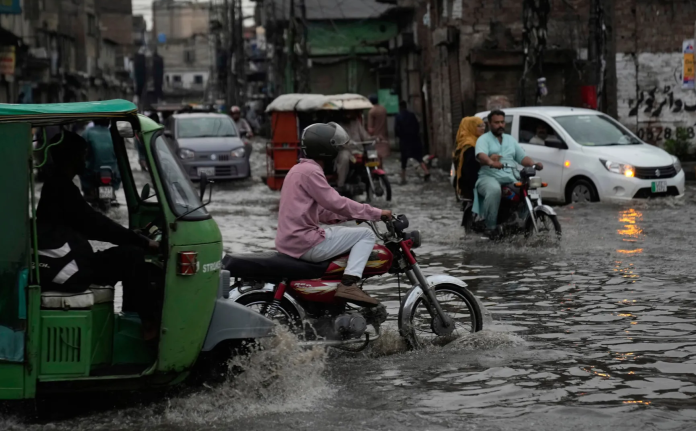Flooding has once again wreaked havoc in
Islamabad and Rawalpindi — the twin cities — and many other regions of Pakistan, claiming precious lives, damaging property, and leaving countless people displaced. Sadly, the worst affected are always the most vulnerable: those living in low-income neighborhoods and mud houses, often built along the banks of seasonal waterways. Year after year, the country experiences heavy rains, and year after year, the same story unfolds — lives lost, homes destroyed, and the government offering only lip service.
This is not a new phenomenon. In 2021, torrential rains caused severe urban flooding in Islamabad’s Sector E-11. The sector, which once had natural stormwater drains and seasonal nullahs, was heavily built upon in the name of “development.” Real estate developers, with the alleged support or willful negligence of government officials, built residential complexes and commercial buildings right on the natural drainage systems. As a result, when the rains came that year, the water had nowhere to go. Entire buildings were inundated, cars floated down streets, and lives were lost — including a child who drowned in a basement apartment.
Fast forward to 2025, and the story remains tragically the same. In Rawalpindi, the notorious Nullah Lai — once a vital waterway — has turned into a death trap. Encroachment along its banks continues unabated, and the government’s failure to desilt or maintain the nullah has worsened the problem. Whenever the monsoon season arrives, the nullah overflows, washing away everything in its path. The destruction this year has been widespread: dozens of homes destroyed, several people killed, and thousands displaced.
Yet despite repeated disasters, the fundamental issues remain unaddressed.
The primary reasons for the recurring devastation are well known. Natural drainage systems, seasonal nullahs, and waterways that once carried stormwater away from urban areas have been blocked, filled, or built over. Real estate developers, in collaboration with corrupt government officials, continue to construct high-rises and housing societies on what used to be essential floodways. The problem is not just illegal construction — it’s systemic failure.
Standard Operating Procedures (SOPs) for urban development are rarely followed. In theory, every construction project is supposed to undergo environmental and safety evaluations. In practice, bribes change hands, and rules are bypassed. No long-term urban planning, no zoning enforcement, and no accountability. The result? The cities become death zones during the monsoon season.
Behind every flooded street and collapsed house is a human tragedy. The victims are overwhelmingly poor people who build their homes in unsafe areas because they have no other choice. Land in formal sectors is prohibitively expensive. The government has no effective low-income housing schemes, leaving the poor to fend for themselves.
In Rawalpindi, for instance, entire communities live along Nullah Lai, knowing full well the risk involved. Yet they stay because they have nowhere else to go. These are families who earn just enough to survive — daily wage workers, laborers, widows, and the elderly. When the floodwaters come, they lose everything: homes, possessions, even loved ones. The trauma is immeasurable.
Each year, as the rains begin, the authorities make vague promises of relief and rehabilitation. A few rescue teams are sent, some emergency shelters are set up, and press releases are issued. But when the water recedes, so does the attention. There is no accountability, no real planning, no long-term investment in flood prevention infrastructure.
Even where some projects have been proposed — like the long-delayed Lai Expressway and flood channeling system — progress is slow, mired in bureaucratic red tape and corruption allegations. Political will is lacking, and governance remains reactive rather than proactive.
Poverty is at the heart of the problem. It forces people into vulnerable areas. It prevents them from rebuilding. It keeps them dependent on the same corrupt systems that exploit them. With no affordable housing options, the poor resort to building makeshift homes near nullahs and flood-prone zones. These homes are made of mud and wood, lacking foundations, proper roofing, or drainage. They stand no chance against rising water levels.
Moreover, the economic cost of repeated flooding is devastating for poor households. Whatever meager savings they have go into rebuilding each year, only to be wiped out again. With rising inflation, joblessness, and no safety net, these communities are stuck in a vicious cycle of disaster and poverty.
The situation is not hopeless, but it demands urgent and systemic change. Here are some concrete steps that must be taken:
1. Restore and Protect Natural Waterways: All seasonal nullahs and stormwater drains must be cleared, restored, and protected from encroachments. Construction on natural drainage paths must be strictly prohibited, and existing encroachments should be removed with proper rehabilitation plans for displaced residents.
2. Accountability for Corruption: The practice of approving illegal housing societies and constructions through bribery must be stopped. An independent commission should be set up to investigate and hold accountable the contractors, developers, and government officials involved in these deals.
3. Low-Income Housing Schemes: The government must introduce and expand affordable housing plans for low-income citizens. Safe housing in planned urban areas must be made accessible through subsidies, micro-loans, and land allocation.
4. Urban Planning and SOP Enforcement: Urban development authorities need to enforce existing building codes, environmental assessments, and zoning regulations. No project should be approved without a proper flood-risk analysis.
5. Public Awareness and Community Preparedness: Local communities must be involved in flood preparedness programs. Early warning systems, evacuation drills, and community response teams can save lives during disasters.
6. Investment in Infrastructure: Massive investment is needed in urban drainage, sewerage, and flood protection infrastructure. Cities like Rawalpindi and Islamabad cannot afford to function on decades-old systems that were never designed for today’s population.
The current flooding is not just a natural disaster — it is a man-made tragedy. It is the result of years of mismanagement, corruption, and neglect. The victims are not just statistics; they are human beings who deserve better.
If there is any silver lining, it is that these repeated disasters serve as a wake-up call. We can no longer ignore the cost of inaction.

















